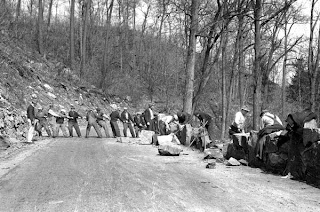
What’s there not to like about lighthouses? Most have a majestic beauty about them and a link to 100’s of years of history. Let’s not forget that the majority have a few ghost tales attached to them as well. Some involve a past lighthouse keeper who is still carrying out their duties and some involve an accidental death but not many have the history that Execution Rocks has which makes it one of the most haunted places in America.
The Execution Rocks Lighthouse is located about a mile off the coast of New Rochelle, NY in the west end of the Long Island Sound. The name itself has a popular, yet based in folklore, story behind it. The British regime in America started to avoid public execution of the Colonials fearing it would spark the spirit of the new Americans and push them closer to a revolution. Instead they took the condemned prisoners out to the reefs at low tide and chained them to the rocks. They would them watch them drown slowly as the tide came in.
To make it even worse, it is said that the old bodies were left there so the newly condemned had the added horror of looking at old skeletons still chained to the rocks. Again this story, though horrific, has not been linked to any historical records but one of the claims of the island is that these condemned prisoners got their revenge years later during the Revolutionary War when a ship of British soldiers were sent after George Washington, the ship sunk near the rocks and no soldier survived.
Another story, maybe a little more ordinary, is that many ships on their way to Manhasset Bay where run aground on the reef and making the ships “executed” on the rocks. The lighthouse at Sands Point was not sufficient to warn ships around Execution Rocks so in 1847; Congress approved $25,000 to build a lighthouse right on the reef, it was first lit in 1850.
The lighthouse keepers lived in the base of the lighthouse until a keepers house was built in 1867. The lighthouse survived two rather minor fires in 1918 and in 1921. It went totally automatic in 1979 and in 2007 the Coast Guard offered the lighthouse to entities under the National Historic Lighthouse Preservation Act of 2000 and in 2009 the Historically Significant Structures organization received the deed for the lighthouse. Currently they are trying to raise funds and turn Execution Rocks into the first Long Island lighthouse to offer overnight excursions.
Another gruesome connection to the lighthouse is that of serial killer Carl Panzram. In the early 20’s, Panzram turned a .45 colt revolver stolen from a burglary into a killing spree that ended up with rocks being tied to bodies and dumped about 100 yards from the Execution Rock lighthouse. Panzram himself claimed to kill 21 people and was truly an evil and unremorseful human being. He was once quoted after killing and 12 year old boy, “….I am not sorry. My conscious doesn’t bother me. I sleep sound and have sweet dreams.”
Though the last lighthouse keeper, who retired in 1970, claims he never saw a ghost, paranormal activity claims such as apparitions, footsteps, voices and strange sounds have been reported by many who pass by the lighthouse as well as many US Coast Guard personnel who took night shifts there until the automation was finished.~TRAVEL CHANNEL~
OMG, SCARY SCARY...RUN...






































